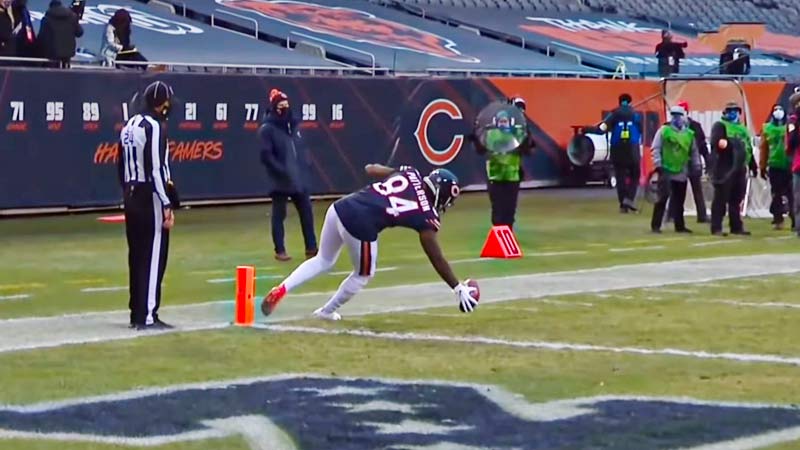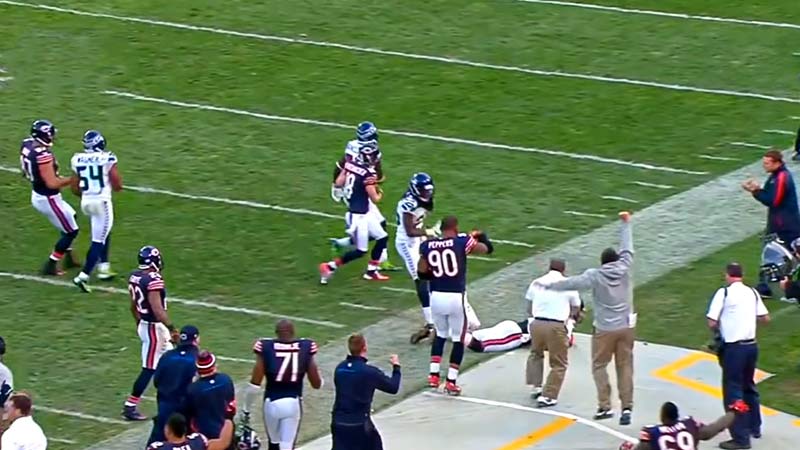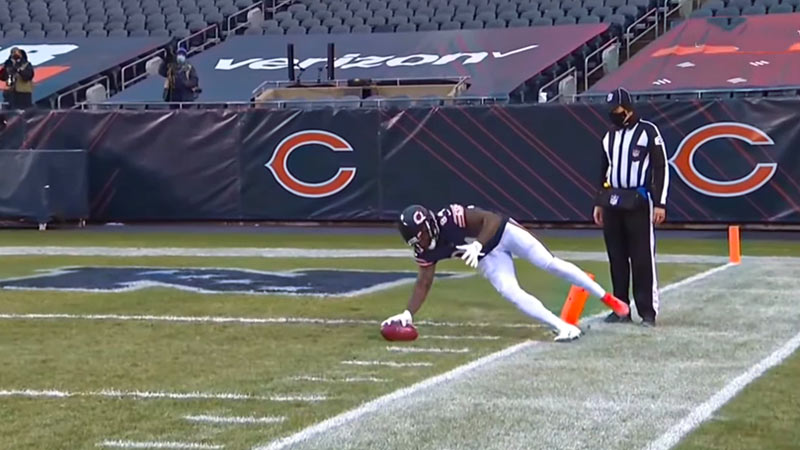The intricate rules of American football are essential for fans, players, and enthusiasts alike. Among the myriad of regulations that shape the game, the concept of “out of bounds” rules holds a significant role.
These rules not only define the physical boundaries of the field but also influence strategies, field position changes, clock management, and player safety.
In this comprehensive guide, we delve into the frequently asked questions surrounding out-of-bounds football rules, shedding light on their impacts and intricacies. So, stay focused.
What Is the Out of Bounds in American Football?
In American football, the term “out of bounds” refers to the area outside the playing field’s designated boundary lines. The playing field is a rectangular area with marked sidelines and end zones.
When a player, the ball, or any part of the ball carrier’s body touches or crosses these boundary lines, they are considered “out of bounds.” When this happens, the play is immediately stopped, and the ball is declared dead.
The team possessing the ball at the time gains no further yardage beyond the point where the player went out of bounds. Additionally, the clock stops temporarily, allowing players to reset for the next play.
Out-of-bounds rulings play a crucial role in determining field position, maintaining player safety, and controlling the flow of the game in American football.
Out-of-Bounds Football Rules
In American football, the “out of bounds” rules dictate how the game is played when the ball or players cross the boundary lines of the playing field. Here are the key aspects of the out of bounds rules:
Ball Out of Bounds
If the football goes out of bounds, either through the sidelines or into the end zone, the play is considered dead.
The team that was last in possession of the ball when it went out of bounds loses possession, and the opposing team gains possession at a designated spot on the field. The specific spot varies based on where the ball went out of bounds.
Player Out of Bounds
If a player carrying the ball steps or is pushed out of bounds, the play is stopped, and the ball is declared dead. The ball is spotted at the point where the player went out of bounds. Incomplete passes that go out of bounds are also subject to this rule.
End Zone Out of Bounds
If a ball carrier carries the ball into the end zone but steps out of bounds before scoring a touchdown, the result is an “out of bounds” ruling. This is different from a touchdown, and the team’s offensive series continues from the line of scrimmage.
Clock Management
The game clock stops temporarily when a play ends due to the ball or a player going out of bounds. This gives teams more time to set up and plan their next play.
Player Safety
The out of bounds rules help protect players from potential collisions with the sidelines or barriers. Once a player steps out of bounds, opposing players are expected to avoid unnecessary contact.
Challenges and Reviews
Out of bounds calls can be subject to review if a coach challenges the ruling on the field. Video replay may be used to determine whether a player actually went out of bounds or if the ball crossed the boundary line.
These out of bounds rules are essential for players, coaches, and fans alike, as they influence field position, possession changes, and the overall strategy of the game.
Implementation of Bounds Football Rules

The out of bounds rules in American football are implemented consistently across different levels of play, including the NFL, NCAA (college football), and high school football.
While the core principles remain the same, there might be some nuanced differences in terms of field dimensions, instant replay usage, and specific regulations. Here’s how these rules are generally implemented at each level:
NFL (National Football League)
- In the NFL, the field dimensions and out of bounds rules are standardized. The field is 120 yards long and 53.3 yards wide, including end zones that are 10 yards deep. If a player touches the sideline or end line with any part of their body or the ball, they are considered out of bounds.
- Coaches can challenge out of bounds rulings, and these challenges can be reviewed through instant replay. If a player goes out of bounds while making a catch, officials review whether the player had complete control of the ball before going out.
NCAA (National Collegiate Athletic Association)
- College football follows similar out of bounds rules to the NFL. However, there might be variations in field dimensions in NCAA football based on the stadium.
- Like in the NFL, coaches in college football can challenge certain calls, including those related to out of bounds situations. Instant replay is used to review these challenges.
High School Football
- High school football adheres to the fundamental out of bounds rules observed in higher levels of play. However, there could be variations in field dimensions based on the school’s facilities.
- In some high school games, depending on the officiating crew and available technology, instant replay may not be used as extensively as in the NFL or NCAA.
Across all levels of play, the implementation of out of bounds rules serves the purpose of maintaining fairness, player safety, and consistent gameplay.
The rules contribute to determining field position, possession changes, clock management, and the overall flow of the game.
Penalties for Violating Out of Bounds Rules

Violating out of bounds rules in American football can result in penalties, which are enforced to maintain fair play, uphold the integrity of the game, and discourage intentional rule infractions.
The penalties can vary based on the specific circumstances and level of play (NFL, NCAA, high school). Here are some common penalties associated with violating out of bounds rules:
Illegal Out of Bounds
- This penalty is typically called when a player goes out of bounds voluntarily and then re-enters the field of play to participate in the play. This is often seen with receivers trying to gain an advantage by coming back onto the field after going out of bounds.
- The penalty usually results in an illegal touching penalty, and the play is blown dead at the spot where the player re-entered the field. The offense incurs a loss of down or a five-yard penalty, depending on the level of play.
Personal Foul: Out of Bounds Hit
- If a player delivers a hit on an opponent who is already out of bounds, it can lead to a personal foul penalty for unnecessary roughness or a late hit.
- This penalty results in a 15-yard advancement for the opposing team, along with an automatic first down if it’s against the defense.
Kickoff or Punt Out of Bounds
- If a kickoff or punt goes out of bounds without first touching a player inbounds, it results in a penalty. The receiving team can choose to take the ball at the 40-yard line (NFL) or have the kicking team re-kick from 5 yards back (NCAA).
- In high school, the rule may vary, but a similar penalty applies.
Illegal Block Out of Bounds
- If a player initiates a block on an opponent who is out of bounds, it can lead to an illegal block penalty.
- This penalty results in a loss of yardage, usually 10 yards from the spot of the foul.
Sideline Interference
- Coaches, players, and team staff are expected to stay clear of the sideline and not interfere with the progress of the game. Interfering with the play or an official can result in sideline interference penalties.
- The penalty usually results in a 15-yard penalty or a warning for the first offense, and subsequent offenses can lead to more severe penalties.
Unsportsmanlike Conduct
- If a player, coach, or team staff member behaves unsportingly, such as taunting an opponent who is out of bounds, they may be penalized for unsportsmanlike conduct.
- The penalty usually results in a 15-yard penalty and can be a significant factor in determining field position.
Penalties for violating out-of-bounds rules serve as a deterrent against unfair play, promote player safety, and ensure a level playing field for both teams.
Impact of Out-of-Bounds Rules

The out-of-bounds rules in American football have a significant impact on various aspects of the game, shaping strategy, field position, player safety, clock management, and overall gameplay. Here are some key impacts of these rules:
Field Position and Possession Changes
The most immediate impact of out-of-bounds rules is on field position. When the ball goes out of bounds, whether carried by a player or kicked, the team in possession loses yardage, affecting their advancement toward the opposing end zone.
Additionally, possession can change hands if the ball carrier goes out of bounds, resulting in turnovers that can shift momentum.
Clock Management
The clock stops temporarily when a play ends due to the ball or a player going out of bounds. This stoppage provides teams with more time to plan their next play, strategize, and potentially execute a hurry-up offense. It also contributes to managing the game’s overall pace and timing.
Player Safety
Out-of-bounds rules are designed to enhance player safety by preventing unnecessary collisions with boundaries, walls, or obstacles beyond the field.
When a player steps out of bounds, opponents are expected to avoid unnecessary contact, reducing the risk of injuries that could occur in such situations.
End Zone Dynamics
Out-of-bounds rules apply to the end zones as well. A player who carries the ball into the end zone but steps out of bounds before scoring a touchdown has their play deemed out of bounds.
This rule prevents players from gaining an unfair advantage by taking shortcuts or evading defenders by going out of bounds and re-entering.
Strategic Considerations
Coaches and players must consider out-of-bounds rules when developing their strategies. Offensive players may use the sidelines to their advantage to avoid defenders or gain extra yardage before stepping out. On the defensive side, players may push opponents out of bounds to stop a play and regain possession.
Challenge and Review Opportunities
Coaches have the option to challenge certain out-of-bounds calls using video replay. These challenges can influence the outcome of the game by reversing or confirming the initial ruling. This adds a layer of strategic decision-making for coaches and introduces an element of uncertainty to the game.
Special Teams Play
Out-of-bounds rules are crucial in the context of special team plays, such as kickoffs and punts. A kickoff or punt going out of bounds can lead to an advantageous field position for the receiving team, potentially impacting their offensive strategy.
Flow of the Game
The out-of-bounds rules contribute to the ebb and flow of the game. Stops in play due to players going out of bounds provide moments of rest and regrouping, impacting the overall rhythm and intensity of the match.
So, the out-of-bounds rules in American football go beyond defining the physical boundaries of the field.
FAQs
What exactly are out of bounds football rules?
Out of bounds football rules dictate what happens when a player, the ball, or any part of the ball carrier’s body crosses the designated boundary lines of the playing field. When this occurs, the play is halted, and various consequences come into play, ranging from changes in possession to clock stoppages.
How do out of bounds rules impact field position?
When the ball goes out of bounds, the team in possession loses yardage, affecting their advancement toward the opposing end zone. Additionally, possession can change hands if the ball carrier goes out of bounds, leading to turnovers that can significantly shift the momentum of the game.
What role do out of bounds rules play in player safety?
Out of bounds rules prioritize player safety by preventing unnecessary collisions with boundaries or obstacles beyond the field. These rules ensure that players stepping out of bounds are not subjected to undue contact, reducing the risk of injuries in such situations.
How do these rules affect clock management?
The clock temporarily stops when a play concludes due to the ball or a player going out of bounds. This stoppage grants teams more time to plan their next moves, possibly executing a hurry-up offense. This factor influences the game’s pace and timing.
Can coaches challenge out of bounds calls?
Yes, coaches can challenge certain out of bounds calls through video replay. These challenges can have a substantial impact on the game by confirming or reversing the initial ruling. This introduces a strategic dimension for coaches and adds an element of suspense to the proceedings.
Wrapping Up
As we’ve explored in this guide, out of bounds football rules extend beyond simple field boundaries. They shape the strategic landscape, impact field position dynamics, ensure player safety, influence clock management, and define the essence of the game.
Whether you’re a casual observer or a die-hard fan, grasping these rules adds a layer of depth to your understanding of the sport.
As the game evolves, so too do the strategic implications of its rules, making American football a captivating blend of athleticism and intellect. Thank you for your support.







